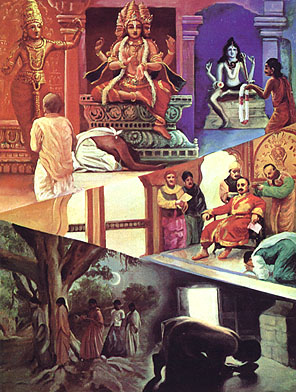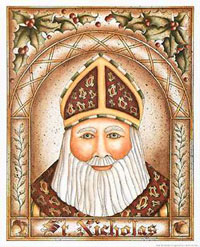
Worship in the Three Modes of Material Nature
updated 12th December 2004

Worship in the Three Modes of Material Nature
updated 12th December 2004
Guy Fawkes night - "bon-fire night":
Like so many festivals around the world many of them have their origins in religious service or practice. The unfortunate truth keeps presenting itself in that mundane personalities have changed the emphasis and materialised many of these ancient natural celebrations for temporary profit and gain. In so doing they have lost the vital essence of the celebration and with it the true religious and cultural meanings.
One might well ask then why do the masses go along with this, and the answer is simple - because there are little or no brahminical teachers who are giving direction on what is to be done and what is to be avoided - that brings ignorance and consequential suffering.
Because over the years the brahmins (clergy) and kshatriyas (administrators) became corrupt and were rejected in most cultures in the world, the baby was thrown out with the bath water, and mundane communism and anarchy prevailed under the cloak of progressive change (socialism - liberalism). Yet, we have seen that it didn't work, and many are again looking for what is needed.
All the world over people are giving up the concocted "isms" and returning to religious principles.
Krishna consciousness is the prime positive alternative to these other ways of life, and despite the short comings that may easily be found in this world, this movement is pushing ahead and preaching vigorously to satisfy the mission of Sri Chaitanya Mahaprabhu, and Lord Sri Krishna. None of the other mundane festivities of this world will help in this regard.
One may try to gain temporal satisfaction out of watering every desire and whim that comes to surface in our being, BUT the real source of satisfaction comes from uniting the soul to the Lord of the souls. Without such Yoga satisfaction of a permanent nature will not be found - it will not be found through any amount of lavish spending on presents, which are likened to blowing on a boil; or through intoxication that make the problems and suffering temporarily seem to not exist; or through absorbing oneself in fantasies of a sexual nature; or hoping against hope that one's gambling will bring solutions and relief of the suffering.
No, there is no alternative to becoming conscious of the root of everything. For to water the root is to satisfy all parts or limbs of the tree. That is why this Krishna consciousness movement is so simple and sublime, because it gives anyone, in any situation the opportunity to do something, anything to help develop their original constitutional position as a spiritual being, that has no suffering, no anguish, is eternally existent, and always happy.
Please turn to Krishna
for your solutions to life's problems, be they big or small, and in
that way give up other dharmas (Bhagavad Gita
18:68.)

To read the following article you will need the Balaram font installed on your system. Download it HERE for Free, and then install it on your computer.
Observing Secular Holidays
By Ürmilä Devé
Däsé
THE YEAR IS FULL of holidays and
special events unrelated to spiritual life. Even in India, where Janmäñöamé,
the anniversary of Kåñëa's divine birth, is a general
festival, many other days are dedicated to the country or some ordinary,
materialistic person. Outside of India, festival days sometimes even focus
on demonic beings such as witches. National holidays, and even religious
festivals such as Christmas, are often occasions for diving into intoxication,
illicit sex, and materialistic life in general.
If we wish to raise our children
to be absorbed only in thoughts of Lord Kåñëa, how should
we treat these secular holidays? One approach is, as far as possible, to
ignore them. We can tell our children that although the preparations they
see around them—sometimes for weeks before the holiday—are certainly attractive,
we are interested only in celebrating the Lord’s glories. Children can
be satisfied and happy without getting into mundane festivities, especially
if their year is full with one exciting devotional festival after another.
Adults often think, however, that
because their children will hanker for what glitters all around them, the
children must have at least a little of the outside celebration in order
not to feel resentful or deprived. Perhaps the adults themselves feel there
is something worthwhile in mundane events, or aren’t fully satisfied in
spiritual life. But sometimes even when a child’s parents are fully convinced
that observing devotional holidays is sufficient, avoiding materialistic
celebrations is difficult. Nondevotee relatives, or even other devotees
of Kåñëa, may want to pull one into the celebrations,
and that influence may be hard to avoid.
A second approach, therefore, is
to find a way of relating nondevotional celebrations to Kåñëa.
For an originally religious holiday such as Christmas, it is relatively
easy to have programs about the life and teachings of Lord Jesus. On Mother’s
Day, we can have our children honor their mothers, grandmothers, mother
cow, and mother earth. Sometimes a policy of making special days Kåñëa
conscious can lead to creative results. For example, one year on Halloween*
some of my high school girls dressed up as male devotees and went door
to door selling Çréla Prabhupäda's books. We can take
our children out to sing the Lord’s names through the crowds that gather
for national independence day and other such holidays. On one U.S. holiday
(Thanksgiving), we used to take our students in Detroit to the local Hare
Krishna Food for Life center to distribute free prasädam, food offered
to Lord Kåñëa.
* On Halloween night in the United
States, children dress in costumes and go from house to house collecting
candy and other treats.
If we decide to have our children
celebrate mundane occasions in the same way as the materialists, we greatly
risk raising children whose idea of happiness is materialistic. Holidays
are the highlights of life, especially for children, who even at a young
age note the number of weeks or days until their favorite festival. When
these days involve simply sense enjoyment—which for a child can mean games,
presents, fireworks, and special food—we indirectly teach that we are living
for material pleasure.
Observing our children’s birthdays
poses a special problem. In the early days of the Hare Kåñëa
movement, when Çréla Prabhupäda was present with us,
we rarely, if ever, noted the birthdays of our members, including children.
Gradually, however, birthday parties, especially for children, have become
more and more common. Once I calculated that every year in the community
where I lived we had three times as many birthday parties as devotional
festivals. I noted that the children often had “birthday parties” as part
of their play.
Should we eliminate birthday parties?
That’s probably impossible. We can, however, follow Çréla
Prabhupäda's direction that a birthday is a time for charity and austerity.
Our children can give gifts on their birthday, rather than receive them.
Gatherings can be small and simple so as not to appear to compete with
spiritual festivals. And when we invite a few friends for cake and ice
cream, we can also read from scripture and chant together.
Our children should grow up convinced
that the happiness of Kåñëa's devotees surpasses all
the happiness of the material world—even a party.
Ürmilä Devé Däsé
and her family run a school in North Carolina. She is the major author
and compiler of Vaikuëöha Children, a guide to Kåñëa
conscious education for children.
Sharing the Spirit of Christmas - The aromas wafting through Christmas kitchens bring joy to some hearts—but pain to others.
by Viçäkhä-devé däsé
Back to Godhead Magazine 21st December 1986
“Sharing—that's the heart of Christmas!"
chimes Better Homes and Gardens. "To celebrate, people share traditions—from
gift-giving to party-going—with family, friends, and acquaintances too.
And food plays a special part in these yuletide activities. Christmas just
wouldn't be Christmas without the aroma of the festive bird and baked goods
wafting through the kitchen! ... Once the sharing begins, and you've sampled
our treats, you'll realize that fellowship and food go hand in hand in
making your holidays memorable."
Typical December tidings? Yes. But
for some, those tidings and the accompanying full-page color photo of a
stuffed "festive bird" evoke a shudder. Certainly sharing is the heart
of Christmas, and giving and receiving food can be a heartfelt exchange.
But killing and eating living beings in the name of sharing is definitely
not the spirit of Christmas.
Fellowship and sharing should be
extended to all God's creatures. Just as a father is horrified to see one
of his children killed, so the original father. God, is pained to see our
violence toward His other creatures. Desiring to protect His family. He
clearly enjoins, "Thou shalt not kill."
That should be clear enough. Still,
we hear: "God put the animals here for us to eat." "We need to eat meat
to get enough protein." "God didn't really mean don't kill, just don't
murder." And so forth.
In this column and in other sections
of Back to Godhead magazine we regularly answer these challenges. Also,
doctors, nutritionists, economists, ecologists, religionists, and others
have presented compelling support for a vegetarian diet. And great Western
minds from Pythagoras to Shaw have reflected on and extolled the virtues
of vegetarianism.
Yet for Çréla Prabhupäda,
the founder and spiritual master of the International Society for Krishna
Consciousness, being vegetarian was not enough. "Even the pigeons are vegetarian,"
he remarked. His standard—the one he introduced throughout the world with
unprecedented success—is to use pure vegetarian ingredients and devotion
for God in preparing meals. And the finished dishes are offered to Lord
Kåñëa with love. (This attitude is called bhakti, a Sanskrit
word that comes from the root bhaj, which means "to share.") Vegetarian
dishes so offered are called prasädam, or "the Lord's mercy." And
one who prepares them, offers them, or eats them transcends mere vegetarianism.
Certainly the vegetarian is right
to refrain from "sharing" a Christmas turkey, yet even a vegetarian must
kill some form of life to eat. To absolve ourselves of the reaction for
killing vegetables, to purify our minds, to give strength, health, and
satisfaction, and to increase our consciousness of the supreme father,
from whom everything has come, we should eat only the Lord's prasädam,
vegetarian food prepared for Lord Kåñëa and offered to
Him with love. One who shares prasädam shares spiritually, and so
shares the spirit of Christmas in harmony and fellowship with all of God's
creation.
This month we're including some
recipes that will capture the spirit of Christmas without causing unnecessary
pain to other creatures. Prepare these dishes—or any other vegetarian dishes—and
offer them to Kåñëa with devotion. You 'II be sure to
have the merriest Christmas ever.
Curd Patties in Tomato Sauce
Preparation time: 1½ hours
Servings: 8–10
Ingredients:
½ cup ghee (clarified butter)
or vegetable oil
2 teaspoons turmeric
2 teaspoons ginger powder
4 teaspoons ground coriander
1 teaspoon cayenne pepper
16 medium-size tomatoes
3 teaspoons salt
2 bunches spinach, washed and cut
into 3-inch lengths
ghee or vegetable oil for deep-frying
curd from
2 gallons of milk
2 cups sour cream
1. To make the tomato sauce, heat
the ½ cup of ghee in a saucepan on a medium flame and add all the
spices except the salt. After a minute or two, add the tomatoes. When the
tomatoes cook down a little, add the spinach and salt. Lower the flame.
2. To make the curd patties, wrap
the curd in a cloth and press under a heavy weight for about five minutes.
Then knead the curd on a smooth surface until it becomes almost like cream
cheese. Heat the ghee (for deep-frying) in a medium-size wok over a medium
flame. Shape the curd into patties and place them into the hot ghee. Cook
the patties until they are golden brown, turning them as required.
3. Remove the curd patties from
the ghee and add them to the tomato sauce. Simmer for at least one hour.
Stir in the sour cream and offer to Kåñëa.
Cheese Souffle
Preparation time: 1½ hours
Servings: 12
Ingredients:
1 cup milk
2 tablespoons yogurt
¾ cup flour
½ teaspoon salt
dash cayenne pepper
¼ pound coarsely grated Muenster,
Colby, Cheddar, or Jack cheese (make sure it contains no animal rennet)
vegetable shortening
1. Mix ½ cup of milk, the
yogurt, and the flour in a bowl and beat lightly with a whisk until smooth.
Stir in the salt, cayenne pepper, and remaining milk. Let the batter stand
for one hour.
2. Add half of the cheese to the
batter and stir. Grease an 8-inch pie plate with vegetable shortening,
'pour in the batter, and bake in a preheated 425° oven for 30 minutes,
or until puffed and brown.
3. Scatter the remaining cheese
on top and bake until the cheese is melted. Cut into 12 narrow wedges and
offer to Kåñëa.
French Salad Dressing
Preparation time: 10 minutes
Servings: 2½ cups
Ingredients:
1 cup salad oil
2/3 cup tomato puree
½ cup lemon juice
½ cup sugar
1 teaspoon salt
1 teaspoon dry mustard
1 teaspoon asafetida
dash black pepper
Put all the ingredients in a blender and mix until blended. Offer to Kåñëa with a salad.
Gravy
Preparation time: 20 minutes
Servings: 10–12
Ingredients:
4 tablespoons melted butter (not
ghee)
½ teaspoon sugar
½ teaspoon asafetida
1½ teaspoons basil
1 teaspoon ground coriander
2 tablespoons chickpea flour
2 tablespoons white flour
1½ cups cool water
1 teaspoon salt
½ teaspoon black pepper
1. Melt the butter in a saucepan
over a medium-low flame and add the sugar, asafetida, basil, and ground
coriander. Saute for a minute or two and then add the chickpea flour and
the white flour. Saute until brown.
2. Add the water slowly, stirring
constantly. Add the salt and pepper. Offer to Kåñëa with
mashed potatoes.
Apple Rice
Preparation time: 40 minutes
Servings: 4–6
Ingredients:
1 cup good-quality long-grain white
rice
4 medium-size apples
2 cups sugar
3 pinches saffron
2 cups water (for the syrup)
3 tablespoons ghee (clarified butter)
or butter
1 cinnamon stick
6 cloves
6 cardamom pods
3 bay leaves
2¼ cups water (for the rice)
¼ cup sliced almonds
¼ cup raisins
1. Wash the rice and drain it. Peel,
core, and cut the apples into chunks. Make a syrup by putting the sugar
and a pinch of saffron in the water and cooking it for 30 minutes over
a medium flame until it reduces to about one third its original volume.
2. While the syrup is cooking, heat
the ghee in a saucepan and toss in the cinnamon, cloves, cardamom, and
bay leaves. Stir-fry for a moment or two; then add the rice. Stir-fry for
2 or 3 minutes. Add the water and bring to a boil. Toss 2 pinches of saffron
into the water, cover the pan, and cook over a low flame for 15 minutes.
Then take the saucepan off the flame.
3. Make a hole in the center of
the rice and place the pieces of apple and a little of the syrup in it.
Add the raisins and the sliced almonds. Cover the hole with rice and pour
the rest of the syrup over the top. Cover the pan again and cook over a
low flame for another 15 minutes, until the rice is completely cooked.
Remove the whole spices, mix gently, and offer to Kåñëa
hot.
One-Pan Carob Cake
Preparation time: 45 minutes
Servings: 10–12
Ingredients:
1 2/3 cups all-purpose flour
1 cup packed brown sugar
¼ cup carob powder
1 teaspoon baking soda
½ teaspoon salt
1 cup water
Ÿ cup melted butter or vegetable
oil
1 teaspoon lemon juice
1 ½ teaspoons natural vanilla
extract (without alcohol)
powdered sugar
1. Heat oven to 350°.
2. Mix the flour, brown sugar, carob
powder, baking soda, and salt with a fork in an ungreased square pan, 8x8x2
inches. Mix in the remaining ingredients. Bake for 35 to 40 minutes or
until a knife inserted in the center comes out clean. Dust with powdered
sugar. Offer to Kåñëa.
For more recipes and further information on Christmas - Xmas see the link HERE
Christmas - Xmas:
The REAL Origins of the Symbols
seen at Christmas - mostly seated in Pagan festivals and meaning later
tied into Christianity to give Christianity some validity with the masses
of the peoples.
 St
Nick - Santa Claus page other Xmas pagesHERE
St
Nick - Santa Claus page other Xmas pagesHERE
More Origins of Symbology and Traditions centred around what we have come to know as Christmas
CHRISTMAS CUSTOMS
AND THEIR PAGAN ORIGINS

Christmas - another
page that clearly defines this event to be mostly in its Pagan roots, that
today has become nothing more than a commercial enterprise feeding off
and manipulating cultural traditions.
Origins of Christmas- an honest portrayal
Ancient Festivals - Some background behind events "Coinciding with Christmas"
A more radical view of the season of Ho Ho Ho......
WORLD
HEADQUARTERS OF THE UN-CHRIST-MASS CLUB
 Now
whose accusing who of Idol worship ?
Now
whose accusing who of Idol worship ?
![]()
 Halloween
- A Samhain ritual: (Wiccan) - A sample of what we are talking about !!!
Halloween
- A Samhain ritual: (Wiccan) - A sample of what we are talking about !!!
Halloween: The Past in the Present by Elspeth Sapphire
The days are shortening and dark comes early. There is a certain crispness to the air as we stroll the streets. Before long, the leaves are turning bright colours, only to slowly drift down to cover yards and streets.
Yes, autumn is here.
And with autumn comes a holiday enjoyed by both old and young...Halloween.
What is the appeal of this night? Why do we find people ranging from infants to grandparents donning costumes and for one night forgetting the mundane?
Halloween, or Samhain to the Pagans, has caught the imagination of people throughout the ages. From the ancient rituals honouring the dead to our modern custom of trick or treating, this one night is our time to put aside any fear of the dark and embrace any that walk there as welcome.
The ancients chose this time of year to celebrate the dead. The harvests were done and the fields laid empty. The days of sun were at a end and the days of dark were beginning. What better time to celebrate the powers of darkness.
This was not a celebration of fear; not always has darkness equalled fear. Instead for those who believed in rebirth, it was a time to reach and touch those beliefs. Just as the fields now laid bare, they would flower again in the spring. And so it was with us, dying only to be reborn.
So many of our Halloween customs can be traced to the past and the habits of our ancestors. Each time I look at the jack-o-lanterns shining with devilish grins, I can picture the original lanterns. Turnips were hollowed out and candles placed inside to protect them from the wind. These lanterns were placed on window sills to guide the dead back to their kin.
Since the apple harvest was celebrated at this same time, apples often played an important place in the festivals. When you bob for apples or dangle apples on strings, you are walking in the footsteps of other people and other times.
What would Halloween be without costumes and masks? Yet, have many of us wondered why we so enjoying the wearing of costumes? Dressing up frees us from the ties of our everyday life. For a brief moment of time, we become a princess or an Indian or a cartoon character. This gives us a freedom of action that we normally wouldn't have.
Masks have also long been associated with death and the gods. Was early man trying to understand death when he put on a mask of a dead one? Perhaps, donning a mask could put us in touch with the gods themselves.
The black cat, familiar to many a storybook witch, was priced because cats could sense the dead. They could be used as a kind of early warning system. Why black cats? What better colour for this time when the darkness rules?
Every where I look, I come face to face with the stereotyped image of the witch. Wicked or not, they all looked alike: greenish skin, a wart, misshapen face, dressed all in black. In these days of striving for the politically correct, many are trying to remove this image from Halloween celebrations. I guess they don't see what I do. I look at the Halloween witches and remember pictures of the dark Goddess, dressed in black and with her high pointed hat. She would wait at the crossroads to guide the dead to their rest until the time of rebirth. Evil? I don't believe so, anymore than I believe death is evil. Instead it is one more symbol that has passed down through the years to spice October 31st.
Just look around. We are surrounded by symbols of the past that we take for granted. The brooms the witches rode. The cauldrons that bubbled with potions vile. Even trick or treating could be traced back to Celts who went house to house collecting treats of apples.
It has been truly said that there is nothing new under the sun. However, this doesn't have to hinder our enjoyment. On Halloween night, you can find me walking the night. Without fear, I will travel, listening to the laughter of the children, as I go back to another time and place.
![]()
![]()
![]()
![]()
 Guy
Fawkes Night:( The
Gunpowder Plot )
Guy
Fawkes Night:( The
Gunpowder Plot ) 
Then what to speak of Guy Fawkes night - the celebration of some would be social reformer, come terrorist, who got caught trying to blow up the houses of parliament in London. Can you imagine if there would be ANY benefit one might gain in honouring such a person ( according to Bhagavad Gita ). Transcription of his trial.
![]()
![]()
Better to honour those who are worthy or becoming worthy of our time, love and devotion - the real social reformers, role models, and leaders of society for us to learn from and serve can be found Here.
sattvät saïjäyate
jïänaà
rajaso lobha eva ca
pramäda-mohau tamaso
bhavato ’jïänam eva
ca
TRANSLATION
From the mode of goodness, real
knowledge develops; from the mode of passion, greed develops; and from
the mode of ignorance develop foolishness, madness and illusion. (Bhagavad
Gita 14:17.)
With a little honest self examination most will agree with what has been said here. For further insights on how to define Truth, it might be worth a look at the Pramanas pages.

![]()